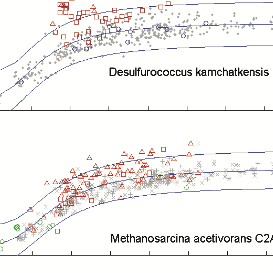Link to online paper: https://peerj.com/articles/3865
Abstract
Background. Horizontal gene transfer, the transfer and incorporation of genetic material between different species of organisms, has an important but poorly quantified role in the adaptation of microbes to their environment. Previous work has shown that genome size and the number of horizontally transferred genes are strongly correlated. Here we consider how genome size confuses the quantification of horizontal gene transfer because the number of genes an organism accumulates over time depends on its evolutionary history and ecological context (e.g., the nutrient regime for which it is adapted). Results. We investigated horizontal gene transfer between archaea and bacteria by first counting reciprocal BLAST hits among 448 bacterial and 57 archaeal genomes to find shared genes. Then we used the DarkHorse algorithm, a probability-based, lineageweighted method (Podell & Gaasterland, 2007), to identify potential horizontally transferred genes among these shared genes. By removing the effect of genome size in the bacteria, we have identified bacteria with unusually large numbers of shared genes with archaea for their genome size. Interestingly, archaea and bacteria that live in anaerobic and/or high temperature conditions are more likely to share unusually large numbers of genes. However, high salt was not found to significantly affect the numbers of shared genes. Numbers of shared (genome size-corrected, reciprocal BLAST hits) and transferred genes (identified by DarkHorse) were strongly correlated. Thus archaea and bacteria that live in anaerobic and/or high temperature conditions are more likely to share horizontally transferred genes. These horizontally transferred genes are over-represented by genes involved in energy conversion as well as the transport and metabolism of inorganic ions and amino acids. Conclusions. Anaerobic and thermophilic bacteria share unusually large numbers of genes with archaea. This is mainly due to horizontal gene transfer of genes from the archaea to the bacteria. In general, these transfers are from archaea that live in similar oxygen and temperature conditions as the bacteria that receive the genes. Potential hotspots of horizontal gene transfer between archaea and bacteria include hot springs, marine sediments, and oil wells. Cold spots for horizontal transfer included dilute, aerobic, mesophilic environments such as marine and freshwater surface waters.
